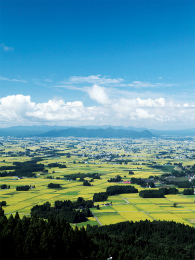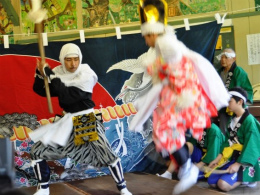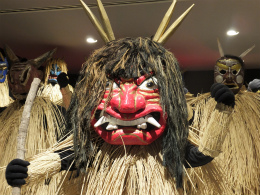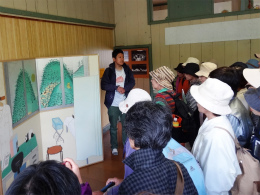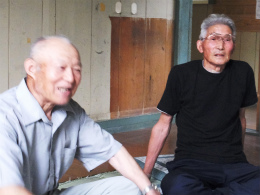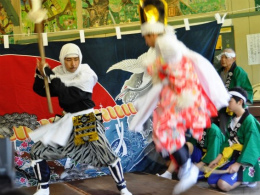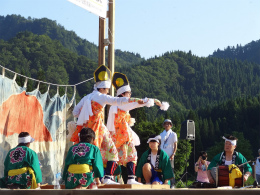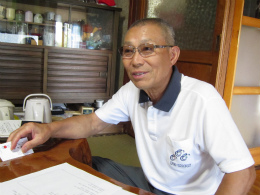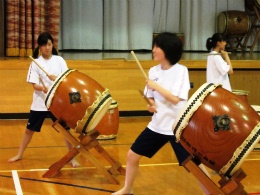Date : August 25 - 26, 2014
Notice: Akita Press Tour
post date : 2014.08.06
―― Passing on Unique Local Culture ――
-Reviving bangaku, a traditional dance once lost due to population decline -
-Maintaining the tradition of namahage, gods of admonishment who visit homes -
-Local food culture, creation of a brand for shottsuru fish sauce -
Akita prefecture is located in the northwest of the Tohoku region. With the Sea of Japan to the west and the Ou Mountains to the east, Akita is surrounded by the sea and mountains and is known as one of the snowiest regions in Japan. Many traditional arts and customs have been passed down through the generations and still exist to this day.
Like many places in Japan, Akita is faced with population decline. People 65 years of age or older account for 31.5% of the population, the highest ratio of any prefecture in Japan, whereas people aged 0 to 14 years old account for only 10.9% of the population, which is the lowest ratio in the country. The issues of an aging population and low birthrate are clearly worsening.
Faced with this situation, there are efforts being made to preserve and pass on the unique local culture.
With its population draining to big cities, Kamikoani in central Akita now only has a population of around 2600. This quiet village is enlivened by the Kamikoani Project Akita, a modern art event held for 66 days over the summer. During this event, artists stay in the village to create art or hold performances. Last year 12,000 people visited the event, 4.6 times the population of the village. Recently bangaku, a form of traditional dance, was revived after 20 years of not being performed. Older residents of the village taught bangaku to elementary and junior high school students so the dance could be put on again. The students perform bangaku as part of the Kamikoani Project Akita as well.
Located on a peninsula extending into the Sea of Japan, Oga also has unique local customs. On New Year’s Eve, local youths put on masks and dress up as namahage, going around to neighboring houses and yelling phrases like “Are there any children here who don’t listen to their parents?” Namahage are gods that admonish laziness and ensure good health, a good harvest and plentiful fish. Oga has various initiatives in place to pass this tradition on to younger generations. There is also a manufacturer dedicated to making a brand out of shottsuru, a fish sauce that is a specialty of Akita.
------------------------------------------------------------------------
This press tour will visit Akita, where unique traditional culture remains alive to this day. Aging populations and decreased birth rates are global issues. The tour will cover people working to preserve traditions in the face of these issues, and a village suffering from population decline that has been energized by an art event.
------------------------------------------------------------------------
※This press tour is sponsored by Akita Prefecture, with planning support by the FPCJ.
Tour Details
[Day 1: Kamikoani]
- - - Revival of a traditional dance in a village faced with population decline - - -
- - - Art event energizing the village - - -
1. Kamikoani Project Akita
A village with a population that declined to 2600; a modern art event bringing in 12,000 visitors.
http://kamikoani.com/?page_id=2
https://www.vill.kamikoani.akita.jp/forms/top/top.aspx
-Mayor of Kamikoani, Mr. Yoshiho Nakata
-Kamikoani Project Akita Director, Dr. Masaya Shibayama (Associate Professor, Akita University of Art)
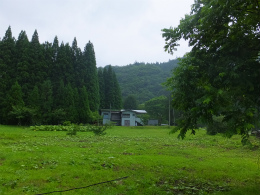 Kamikoani is a village located in central Akita. Surrounded by forested mountains and with a clear stream running through it, this village has long been known for its natural Akita cedar and used to have a thriving forestry industry. However, the declining birthrate and aging population have led to a current population of only 2588. Of all of Akita’s municipalities, Kamikoani has the lowest and oldest population.
Kamikoani is a village located in central Akita. Surrounded by forested mountains and with a clear stream running through it, this village has long been known for its natural Akita cedar and used to have a thriving forestry industry. However, the declining birthrate and aging population have led to a current population of only 2588. Of all of Akita’s municipalities, Kamikoani has the lowest and oldest population.
The Kamikoani Project Akita modern art event was started in this village in 2012. For 66 days, artists from Japan and abroad stay in the village and create art, make exhibits and hold performances based on Kamikoani scenery, such as rice terraces and the elementary school that was shut down. 12,000 people visited the village during the event last year, 4.6 times the population of the village. Young people from around Japan visited Kamikoani, where the percentage of people 65 or over is 46.9%.
Mr. Nakata, the mayor, says the goal of the project is not short-term economic benefits. “Buying and selling things isn’t enough to maintain a relationship. But people who take a liking to the village thanks to this project come repeatedly. When people come from outside and interact with village residents, they ask a lot of questions. That encourages the locals to study, and feel more of an attachment to their hometown.” The goal is to encourage locals to feel pride by bringing in visitors from the outside.
In fact, a company in Tokyo that heard of the village due to the project came and helped out with cleaning as a volunteer group, showing that the village has started to change.
◆The tour will visit Kamikoani while the Kamikoani Project Akita art event is being held and interview the mayor, participating artists and other people involved.
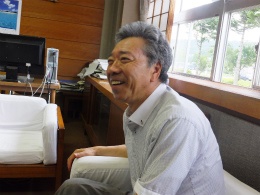

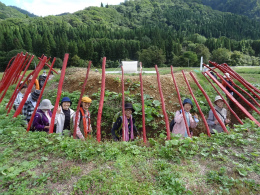
2. Kamikoani Women’s Society
Local women supporting the art event by running a café. “Meeting with young people gives me energy.”
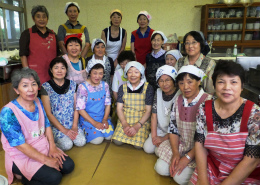 The main location for the Kamikoani Project Akita is the hamlet of Yagisawa, the area furthest into the mountains in Kamikoani. Since there are no restaurants in this area, volunteer members from the local women’s society provide refreshments for visitors. The Kamikoani Women’s Society has 400 members, women in their 50s to 80s, who help with local events. While the Kamikoani Project Akita is being held, they open a café on weekends in the elementary school that has been shut down. They sell homemade curry made with zucchinis and other locally grown vegetables, which is a hit with visitors. According to Ms. Etsuko Takeishi (63), president of the Women’s Society, “At first I thought ‘Modern art?’ But young people are coming from distant prefectures, art students, and it is really impressive. We want to make them feel welcome, and are happy when they finish their plates. We are very careful about hygiene, and have to keep alert when working, but talking with young people gives us energy.”
The main location for the Kamikoani Project Akita is the hamlet of Yagisawa, the area furthest into the mountains in Kamikoani. Since there are no restaurants in this area, volunteer members from the local women’s society provide refreshments for visitors. The Kamikoani Women’s Society has 400 members, women in their 50s to 80s, who help with local events. While the Kamikoani Project Akita is being held, they open a café on weekends in the elementary school that has been shut down. They sell homemade curry made with zucchinis and other locally grown vegetables, which is a hit with visitors. According to Ms. Etsuko Takeishi (63), president of the Women’s Society, “At first I thought ‘Modern art?’ But young people are coming from distant prefectures, art students, and it is really impressive. We want to make them feel welcome, and are happy when they finish their plates. We are very careful about hygiene, and have to keep alert when working, but talking with young people gives us energy.”
◆In addition to interviewing members of the Kamikoani Women’s Society, we will eat curry at the café they operate.
3. Yagisawa, Revival of Bangaku, a Traditional Performing Art
A dance that was lost 20 years ago has been revived
http://common.pref.akita.lg.jp/genkimura/village/detail.html?cid=9&vid=4&id=844
http://common.pref.akita.lg.jp/genkimura/village/detail.html?cid=9&vid=5&id=845
http://common.pref.akita.lg.jp/genkimura/area/detail.html?cid=7&id=707
-Yagisawa Bangaku Preservation Society Chairman, Mr. Toshio Sato (88)
-Mr. Hajime Murata (80)
-Mr. Kinjiro Sato (76)
Yagisawa is the main location for the Kamikoani Project Akita. Located in the south of Kamikoani and surrounded by mountains, it is the most depopulated area in the village, with only 16 seniors living in 9 households. Yagisawa is said to have been settled in the late Edo period (1813), and the residents have maintained a unique culture. A unique dance known as Yagisawa bangaku is one example, a traditional performing art that has been passed down for generations. This bold, vigorous dance is performed to music from flutes and drums, and was a vital part of Obon to put ancestors’ spirits to rest and pray for a bountiful harvest.
When travel became more convenient in the late 1960s, many residents left the hamlet, and there were fewer people to carry on the tradition. A performance of bangaku requires 14 or 15 people, but there were no longer enough people and so performances became infeasible. In 1989, bangaku was no longer seen in the region.
Although Yagisawa bangaku died out once, in 2010 Kamikoani Elementary and Junior High School called for passing on bangaku to younger generations. Mr. Toshio Sato (88) responded to the call, and work began to restore bangaku based on his knowledge. This was done with the help of Mr. Soichiro Mizuhara (27) and Mr. Sugihito Masumoto (41), who came to the village as part of the Regional Development Cooperation Group. They apprenticed themselves to Mr. Sato, learning the fundamentals of bangaku and helping Mr. Sato teach junior high school students. In October 2010, 10 students performed bangaku at the school festival, reviving bangaku for the first time in 20 years.
◆The tour will visit the hamlet of Yagisawa in Kamikoani. Interviews will be held with Mr. Toshio Sato (88) and the other leading authorities on bangaku. Mr. Soichiro Mizuhara (27) and Mr. Sugihito Masumoto, who helped with the revival of bangaku, will also be interviewed at the same time (*See Section 4 for details)
4. Bangaku Performance by Local Elementary and Junior High School Students
Passing down to local children. Activities of the Regional Development Cooperation Group.
http://www.vill.kamikoani.akita.jp/forms/info/info.aspx?info_id=29019
http://common.pref.akita.lg.jp/akitanomiryoku/detail.html?cid=2&id=372
-Kamkoani elementary and junior high school students
-Regional Development Cooperation Group (former)/Regional Stimulation Support Group (current), Mr. Soichiro Mizuhara (27)
- Regional Development Cooperation Group (former)/Regional Stimulation Support Group (current), Mr. Sugihito Masumoto (41)
Students at Kamikoani Elementary and Junior High School are the ones who performed Yagisawa bangaku for the first time in 20 years. Kamikoani Elementary and Junior High School is located in the center of the village, and is the only school since 2007, when due to population decline two elementary schools were merged and a junior high school added. There are 66 elementary school students and 38 junior high school students.
The students were taught by Mr. Toshio Sato (88) and other key figures in Yagisawa who had participated in bangaku in the past. In addition to performing bangaku at school festivals, the students also perform for crowds during the Kamikoani Project Akita.
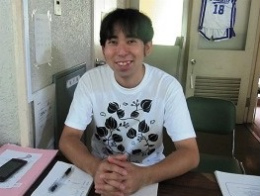 Support for this revival was provided by Mr. Soichiro Mizuhara (27) and Mr. Mr. Sugihito Masumoto (41), a member of the Regional Development Cooperation Group dispatched by the Ministry of Internal Affairs and Communications. The goal of the Regional Development Cooperation Group is to bring in young people from other areas to help stimulate regions where population decline and aging is a significant problem. In 2009, Mr. Mizuhara moved from Kanagawa prefecture and Mr. Masumoto from Shiga prefecture to Yagisawa in order to help older residents out by shoveling snow and farming fields that had been left untended. They also apprenticed themselves to Mr. Sato and Mr. Masumoto, learned the fundamentals of bangaku and then taught it to elementary and junior high school students.
Support for this revival was provided by Mr. Soichiro Mizuhara (27) and Mr. Mr. Sugihito Masumoto (41), a member of the Regional Development Cooperation Group dispatched by the Ministry of Internal Affairs and Communications. The goal of the Regional Development Cooperation Group is to bring in young people from other areas to help stimulate regions where population decline and aging is a significant problem. In 2009, Mr. Mizuhara moved from Kanagawa prefecture and Mr. Masumoto from Shiga prefecture to Yagisawa in order to help older residents out by shoveling snow and farming fields that had been left untended. They also apprenticed themselves to Mr. Sato and Mr. Masumoto, learned the fundamentals of bangaku and then taught it to elementary and junior high school students.
After ending their three year terms with the Regional Development Cooperation Group, Mr. Mizuhara and Mr. Masumoto stayed in Kamikoani and now operate under commission from the village.
◆After watching a performance of bangaku by Kamikoani Elementary and Junior High School students, there will be an interview with them about their role in carrying on this tradition.
[Day 2: Oga City]
- - - The tradition of namahage, gods of admonishment who visit homes on New Year’s Eve - - -
- - - Local food culture. Reviving and creating a brand for shottsuru fish sauce - - -
5. Teachings of Namahage Passed Down in the Region
Gods that admonish laziness and ensure good health
http://www.namahage.co.jp/namahagekan/
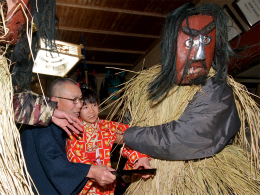
-Oga Shinzan Folklore Museum/Namahage Museum
-Namahage Mask Maker, Ms. Chiaki Ishikawa
On New Year’s Eve, local youths put on masks and dress up as namahage, going around to neighboring houses and yelling phrases like “Are there any children here who don’t listen to their parents?” or “Does the wife of this house wake up early?” To the people of Oga, namahage are gods that admonish laziness and ensure good health, a good harvest and plentiful fish. The households that namahage visit follow old customs and pr
epare food and drink to welcome the namahage.
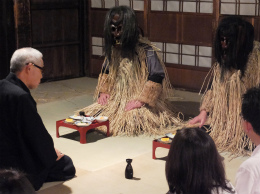 There are a variety of theories on its etymology, but one is that the term namahage comes from namomihagi. Namomi refers to the heat blisters that form after people warm their hands and feet by the fire for too long in the winter. Since they were beings that came to admonish laziness by cutting off (hagi) heat blisters (namomi), they were called namomihagi, which became namahage.
There are a variety of theories on its etymology, but one is that the term namahage comes from namomihagi. Namomi refers to the heat blisters that form after people warm their hands and feet by the fire for too long in the winter. Since they were beings that came to admonish laziness by cutting off (hagi) heat blisters (namomi), they were called namomihagi, which became namahage.
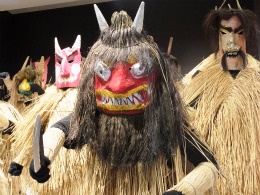 As strange beings that appear out of nowhere and acting violently, children are terrified of namahage. Crying children were a common sight in Oga households during New Year’s Eve. This made a very strong impression on the children, together with the lesson that they should not be lazy. In 1978, the namahage tradition was recognized as a National Important Intangible Folk Cultural Property. Currently, 70 to 80 settlements in Oga carry on the namahage tradition on New Year’s Eve.
As strange beings that appear out of nowhere and acting violently, children are terrified of namahage. Crying children were a common sight in Oga households during New Year’s Eve. This made a very strong impression on the children, together with the lesson that they should not be lazy. In 1978, the namahage tradition was recognized as a National Important Intangible Folk Cultural Property. Currently, 70 to 80 settlements in Oga carry on the namahage tradition on New Year’s Eve.
◆The tour will visit the Namahage Museum, which has displays on the history and importance of namahage, and hear an explanation by a museum guide and interview a mask maker.
Later, we will get to see a live presentation of the Shinzan area namahage New Year’s Ever tradition in a traditional home (Oga Shinzan Folklore Museum). This live presentation provides people who are not locals with the opportunity to see this tradition and helps to communicate its meaning.
6. Shinzan Namahage Preservation Society Chairman, Mr. Noboru Sugawara (70)
Passing down the tradition of namahage as the population declines
http://ww5.et.tiki.ne.jp/~haru228/katudou.htm
The Shinzan area in particularly is known for being serious about passing on the old namahage traditions.
Traditionally, it has been young unmarried men who fill the role of namahage, and currently in Shinzan 7 or 8 members of the local youth group who are in their 20s and 30s do so. The Shinzan Namahage Preservation Society, composed mainly of former youth group members, provides leadership and ensures the tradition is carried on.
Mr. Sugawara, the chairman of the Society, says that namahage have an important role binding people together as a community. Namahage don’t just scare children, they also represent the hope that “The children grow up to be respectable adults, so they don’t get into trouble, and will help protect our home in the future.” Mr. Sugawara was terrified of namahage when he was a child, but once he was in elementary school he also looked forward to New Year’s Eve despite being scared. When he got even older, he wanted to play the part of a namahage himself. “Namahage are gods that protect the region. Back then, even if you wanted to be a namahage it wasn’t easy to get permission to do so. I was very excited when I first acted as a namahage when I was 17. I felt proud to have been recognized as a member of the community, and also started to want local children to grow up into respectable adults. I felt like it was now my turn to help protect the community.”
Mr. Sugawara is concerned about the current situation, with fewer young men around to play the role of namahage and fewer households that can receive namahage due to low birthrates and an aging population. Of the 62 homes in the area, 4 of them have children of junior high school age or younger. There are 12 or 13 homes that can receive namahage. Mr. Sugawara teaches about namahage and provides lessons on making the costumes at local elementary and junior high schools. By discussing the lack of people to carry on the tradition with the children, he feels that the children’s opinions have started to change.
◆There will be an interview with Mr. Sugawara, chairman of the Shinzan Namahage Preservation Society, about initiatives to pass on the namahage tradition to younger generations and the meaning and motivation behind those activities.
7. Oga Kita Municipal Junior High School Namahage Taiko Club
A new kind of performance by junior high school students, using namahage as a motif.
http://www.namahage.ne.jp/~ogakita/index2.php
Namahage taiko is a new style of taiko performance using namahage as a motif that started in the Oga area about 20 years ago. It involves a unique performance where drummers dressed as namahage play Japanese drums. There are several namahage taiko groups composed of Oga youths. By incorporating namahage, a symbol of the region, a new form of expression has been made.
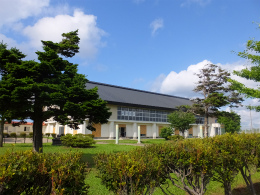 There are also local junior high school students involved in namahage taiko. The group’s name is the Oga Kita Municipal Junior High School Namahage Taiko Club. The school has a total of 37 students. There were around 280 students 20 years ago, but with the population drain to big cities, the aging population and the low birthrate, the number of students has declined drastically. However, of the 37 students in the school, 15 of them are members of the Namahage Taiko Club. Members come to school to practice even during summer holidays, and perform at school festivals and other events. According to second-year student Ms. Yuna Konaka (14), “I saw them at the school festival the year before I started attending this school, and thought they looked cool. I wanted to do it too, because it is something that is only done around here.” Unique to Oga, namahage taiko makes the school livelier.
There are also local junior high school students involved in namahage taiko. The group’s name is the Oga Kita Municipal Junior High School Namahage Taiko Club. The school has a total of 37 students. There were around 280 students 20 years ago, but with the population drain to big cities, the aging population and the low birthrate, the number of students has declined drastically. However, of the 37 students in the school, 15 of them are members of the Namahage Taiko Club. Members come to school to practice even during summer holidays, and perform at school festivals and other events. According to second-year student Ms. Yuna Konaka (14), “I saw them at the school festival the year before I started attending this school, and thought they looked cool. I wanted to do it too, because it is something that is only done around here.” Unique to Oga, namahage taiko makes the school livelier.
◆The tour will visit and watch a performance by the Oga Kita Municipal Junior High School Namahage Taiko Club. We will also speak with the students and their teacher.
8. Unique Akita Food Culture: Shottsuru Fish Sauce
Creating a brand out of local food that nearly faded away.
http://www.slowfoodjapan.net/blog/hinmoku/hatahata/
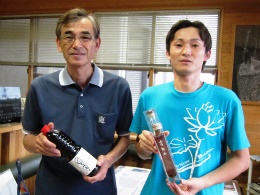 -Moroi Jouzoujo President, Mr. Hideki Moroi (60)
-Moroi Jouzoujo President, Mr. Hideki Moroi (60)
Fish sauce is a traditional condiment throughout China, Korea and Southeast Asia. Thai nam pla and Vietnamese nước mắm are well-known, but there was also a fish sauce known as garum in ancient Rome. It is thought that fish sauce existed in Japan since well before soy sauce was commonly consumed.
Shottsuru is a fish sauce unique to Akita, made using fish such as hatahata (sandfish), a type of fish that was frequently caught around Akita. Hatahata is the official prefectural fish of Akita, and the sight of them coming to shore to lay eggs during harsh winters was welcomed by residents. However, overfishing caused the catch to plummet in the late 1970s. This led to local fishermen carrying out a self-imposed moratorium on catching hatatata for 3 years starting in 1992. This kind of self-imposed moratorium is unprecedented worldwide. With strict management, the catch has been slowly recovering since the moratorium.
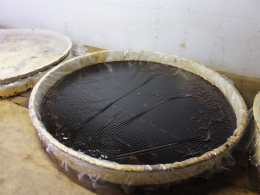 Due to changes in diet and a lack of successors, shottsuru producers slowly vanished. Mr. Hideki Moroi, president of local soy sauce maker Moroi Jouzoujo, rose to the occasion when the hatahata catch recovered. Concerned that the local food culture would vanish if nothing was done, he developed a high-quality shottsuru made from 100% hatahata. It took him 17 years to finally develop a flavor that satisfied him.
Due to changes in diet and a lack of successors, shottsuru producers slowly vanished. Mr. Hideki Moroi, president of local soy sauce maker Moroi Jouzoujo, rose to the occasion when the hatahata catch recovered. Concerned that the local food culture would vanish if nothing was done, he developed a high-quality shottsuru made from 100% hatahata. It took him 17 years to finally develop a flavor that satisfied him.
The shottsuru made with hatahata that Moroi Jouzoujo revived was selected by the Slow Food Foundation for Biodiversity (Italy) to include in its Ark of Taste. In 2013, it was selected by the Japan Tourism Agency as one of 9 “ultimate souvenirs that meet global standards” out of 700 souvenirs from around Japan.
◆We will speak with Mr. Moroi, president of Moroi Jouzoujo, about his efforts to develop shottsuru, Akita’s unique fish sauce, as a brand.
(*Note: Although it will be possible to take pictures of containers that the shottsuru is aging in, the preparation process takes place in winter and so won’t be available to photograph.)
Tour Overview
1. Itinerary: Monday, August 25 to Tuesday, August 26, 2014
[ DAY 1 ]
8:10 Meet at Haneda Airport
8:55-10:05 (1h10m) Haneda Airport to Odate-Noshiro Airport
10:30-11:30 Move from Odate-Noshiro Airport to Kamikoani village by chartered bus
11:30-12:30 Art Project Explanation ①
Project Chairman and Kamikoani Mayor, Mr. Yoshiho Nakata
Project Director, Dr. Masaya Shibayama, Associate Professor, Akita University of Art
12:30-13:15 Kamikoani Women’s Society/Lunch (homemade curry)
13:30-14:15 Art Project Explanation ②
Project Director, Dr. Masaya Shibayama, Resident artists (Mr. Yasunori Kinukawa, Ms. Chen Yijia, etc.)
14:45-16:05 Preserving Yagisawa Bangaku
Yagisawa Bangaku Preservation Society Chairman Mr. Toshio Sato,
Mr. Hajime Murata, Mr. Kinjiro Sato
Former Regional Development Cooperation Group/
Current Regional Stimulation Support Group,
Mr. Soichiro Mizuhara, Mr. Sugihito Masumoto
Yagisawa bangaku performance by Kamikoani Elementary and Junior High School students/interview
16:05-17:05 Art Project Explanation ③
Project Director], Dr. Masaya Shibayama
Regional Stimulation Support Group], Mr. Sugihito Masumoto
17:05-18:50 (1h45m) Move from Kamikoani to Oga Onsen (Oga Kanko Hotel) by chartered bus
[ DAY 2 ]
8:30-9:00 Leave accommodations by chartered bus
9:00-10:00 Akita Food Culture
Shottsuru, Moroi Jouzoujo President, Mr. Hideki Moroi
Namahage
10:00-10:30 Move by chartered bus
10:30-12:10 Namahage Museum, Interview with mask maker, Mr. Chiaki Ishikawa
12:15-13:30 Lunch
13:30-13:50 Oga Shinzan Folklore Museum (namahage reenactment)
14:00-15:00 Shinzan Namahage Preservation Society Chairman, Mr. Noboru Sugawara
15:00-16:00 Move by chartered bus (Stop at Nyudozaki on the way)
16:00-17:00 Oga Kita Municipal Junior High School Namahage Taiko Club/Students, Ms. Itabashi, teacher
17:00-18:30 Move to Akita Airport by chartered bus
19:20-20:25(1h5m) Akita Airport to Haneda Airport
2. Qualification: Bearer of Gaimusho Press Registration Card
3. Cost: 20,000 yen per person including transportation, meals and accommodation
* FPCJ will later inform the participants of methods for payment, cancellation fee etc.
4. Participants: Limited to 10 applicants.
(Only one reporter and one photographer from each company, but two participants from each TV team will be acceptable.)
5. FPCJ Contact: Ms. Chika Yoshida (Tel: 03-3501-3405)
6. Remarks:
(1) There may be some restrictions on photographing and filming at the tour sites. Please follow the instructions of the officials on duty.
(2) FPCJ and Akita Prefecture will not be liable for any inconvenience, trouble or accident that might occur in the course of the tour.




